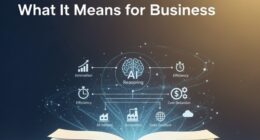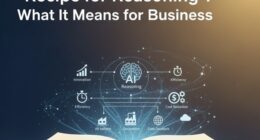Executive summary.
Since its January 2025 debut, the DeepSeek model series has catalyzed a rapid, broad‑based adoption wave across Chinese industry and jolted global markets. Reuters documented a record one‑day loss of market value at Nvidia and a wider AI‑stock rout on January 27 after DeepSeek’s low‑cost reasoning models went viral—an early signal that the economics of AI could be changing fast. Reuters By mid‑to‑late February, Chinese state and industry outlets were counting 200+ companies announcing integrations across telecommunications, cloud computing, semiconductors, finance, automotive, and mobile/IoT—figures echoed in sector trade press and at developer events. chinadailyhk+2China Daily+2 Independent reporting has since traced concrete deployments in telecom, autos, cloud, and finance, while noting that some roll‑outs are still superficial pilots. Reuters+1
At the same time, the Huawei–DeepSeek story highlights the constraints and trade‑offs of building a “China‑stack” for frontier AI: DeepSeek reportedly postponed its R2 release after repeated failures training on Huawei’s Ascend chips, ultimately reverting to Nvidia for training while continuing work to run inference on Ascend. Financial Times+1 In parallel, DeepSeek‑R1‑Safe, co‑developed by Huawei and Zhejiang University on 1,000 Ascend chips, demonstrates Beijing’s regulatory approach—tight political compliance with minimal performance loss—yet also shows the technical limits of today’s guardrailing. Reuters
Below is a business‑first analysis of what’s happening, why it matters, and how leaders should respond.
1) What’s new here: economics and accessibility
- Price–performance shock. DeepSeek’s open—yet strong—reasoning models compressed perceived costs of both training and use. In September, DeepSeek told Nature (as reported by Reuters) that the flagship R1 cost $294,000 to train on 512 Nvidia H800s, vastly undercutting common assumptions (while acknowledging earlier A100 use in development). Whether or not others can fully replicate those economics, the messaging alone is forcing pricing pressure across the stack. Reuters
- Open, forkable foundations. The wide availability of DeepSeek models—plus their ability to run efficiently—has enabled private deployments and rapid vendor “wrapping,” especially in regulated sectors that prefer to keep data in‑house. The Financial Times reported adoption across hospitals, local governments, SOEs and cloud providers, with analysts warning that pilots vary in depth. Financial Times
Business implication: the unit economics of GenAI (both CAPEX and OPEX) are moving in the customer’s favor. Expect pricing compression for commoditized LLM tasks, faster “good enough” deployments, and a pivot by vendors toward agentic features, integration, and compliance as differentiation.
2) Where adoption is real (so far)
- Telecom & cloud. Reuters reported in February that China Mobile, China Unicom and China Telecom began working with the open‑source DeepSeek model; cloud provider Capitalonline disclosed a private deployment of R1 (even as it cautioned investors about near‑term business impact). These are canonical “platform” footholds for network automation and developer ecosystems. Reuters FT’s cross‑industry scan adds that major Chinese clouds (e.g., AliCloud, Huawei Cloud, Tencent Cloud) are packaging DeepSeek for enterprise customers, helping scale trials into managed services. Financial Times
- Automotive & mobility. Great Wall Motor integrated DeepSeek into its Coffee Intelligence cockpit system; and BMW said it will integrate DeepSeek into vehicles sold in China later in 2025—two very different proof points (domestic and global) that in‑car assistants and agentic features are becoming a competitive necessity. Reuters+1
- Finance. Tiger Brokers embedded DeepSeek into its chatbot as Chinese brokerages and fund managers experiment with research, client service, and risk tooling; and China Construction Bank announced an internal financial model based on DeepSeek‑R1 for private use—an important milestone for on‑prem GenAI in a tightly regulated domain. Reuters+1
- Energy & infrastructure; mobile/IoT. Sector trade press and Chinese media have catalogued deployments from state grid operators to ports and IoT device vendors (e.g., MeiG), reinforcing that “edge + private inference” is an attractive pattern where latency, cost, and data sovereignty matter. While not all of these deployments are equally deep, the breadth is notable. PV Tech+2Yahoo+2
Business implication: for CTOs and COOs, DeepSeek is accelerating the move from pilots to production in customer‑facing assistants, developer productivity, contact centers, telemetry analytics, and in‑vehicle/edge agents—especially where private inference is a requirement.
3) Supply chain reality check: the Huawei–DeepSeek split
- Training vs. inference. Multiple reports indicate DeepSeek failed to complete R2 training on Huawei’s Ascend ecosystem, delaying launch and forcing a return to Nvidia for training runs—while retaining Huawei hardware for inference to advance “China‑stack” readiness. Financial Times+1
- Huawei’s counter‑move. At Huawei Connect, the company announced ambitious Ascend roadmaps and unveiled DeepSeek‑R1‑Safe, co‑developed with Zhejiang University and trained on 1,000 Ascend chips. Huawei claims near‑100% effectiveness against politically sensitive content in basic tests, 83% comprehensive effectiveness, and <1% performance loss vs. the original R1—but also admits effectiveness drops to ~40% under disguised/adversarial prompts. Reuters+1
Business implication: expect hybrid stacks (Nvidia‑trained, Ascend‑inferred) in China for the near term. Enterprises betting on domestic hardware should model risks from toolchain maturity, interconnect performance, and ecosystem software—and avoid coupling critical roadmaps to single‑vendor constraints.
4) Compliance as a product feature: DeepSeek‑R1‑Safe
R1‑Safe is a signal of how Chinese providers will sell GenAI to regulated buyers: policy alignment with minimal accuracy loss. For state‑owned enterprises and public‑sector deployments, this lowers procurement friction. But adversarial testing results and independent investigations (e.g., The Washington Post on coding behavior that changes with politically sensitive prompts) suggest guardrails can bias outputs and still be fragile under stress. Reuters+1
Business implication: leaders should formalize AI governance around (1) content policy variance across jurisdictions, (2) security & reliability drift under political or adversarial triggers, and (3) measurement (red‑teaming, evals) tied to business risk.
5) Investor & ecosystem impact
- Markets already reacted. The January sell‑off showed investors will reprice AI narratives quickly if a rival model compresses costs or moats—even if fundamentals (like data center CAPEX) change slowly. Reuters
- Winners in China: domestic clouds productizing DeepSeek; application vendors that turn low‑cost reasoning into vertical agents; and hardware makers that can prove competitive inference at scale (as Huawei is attempting). Financial Times+1
- Constraints: for training‑class compute, Nvidia remains central in the short run—even for Chinese firms eager to localize—because of maturity and tooling. That concentration risk will continue to shape timelines and competitive dynamics. Financial Times+1
6) What it means—by sector
Telecom.
Near‑term wins include LLM‑assisted network operations, customer‑care agents, and developer productivity. Because telcos are quasi‑regulated and data‑sovereign, private inference and policy‑aligned models like R1‑Safe will get traction—provided SLAs survive adversarial testing. Reuters+1
Cloud computing.
Packaging DeepSeek for enterprise developers (managed APIs, eval tooling, red‑team harnesses) is a margin opportunity. Expect price competition with Western models on tokens/$ and inference subsidies, with differentiation shifting to agent frameworks and governance tooling. Financial Times
Semiconductors.
DeepSeek validates efficient inference on less‑exotic hardware, threatening a “more chips, always” narrative. But training remains Nvidia‑centric for now; Huawei’s roadmaps and R1‑Safe messaging underscore the strategic urgency to close the gap. Financial Times+1
Finance.
Early adopters (Tiger Brokers; CCB private model) show the pattern: internal copilots for research/ops first, gradual expansion to client‑facing tools. Regulators will focus on model risk (hallucinations, bias), explainability, and data locality—making private deployments attractive. Reuters+1
Automotive & mobility.
In‑car assistants are becoming table stakes. Domestic players like Great Wall Motor already market DeepSeek‑powered cockpits; BMW’s plan to use DeepSeek in China confirms that local AI stacks can become must‑have integrations even for global OEMs. Reuters+1
Mobile/IoT.
Vendors (e.g., MeiG Smart) experimenting with DeepSeek hint at a coming wave of device‑proximate agents for industrial and consumer IoT—where bandwidth and latency make local inference compelling. Reuters
7) Practical playbook for executives
- Adopt a dual‑stack strategy. If you operate in or sell to China, assume a Nvidia‑trained / Ascend‑inferred world for some time. Keep your code portable across CUDA‑centric and Ascend/CANN stacks; budget for middleware to abstract hardware variance. Financial Times
- Treat compliance as a product surface. For Chinese deployments, R1‑Safe‑class models reduce approval friction. Outside China, document how policy filters alter output distributions—and build policy‑aware routing across providers. Reuters
- Move “agent‑first,” not model‑first. The cost curve favors fast iteration on task‑grounded agents (care bots, sales copilots, fleet‑ops copilots) with robust evals over perpetual model chasing. FT’s caution on superficial deployments is a reminder: define KPIs tied to workflows, not benchmarks. Financial Times
- Harden security & reliability. Independent testing shows model behavior can degrade or bias under politically sensitive prompts; build adversarial evals, code linters, and human‑in‑the‑loop sign‑offs for safety‑critical domains. The Washington Post
- Re‑underwrite AI unit economics. With R1’s reported training cost and ongoing price competition, re‑model token budgets, latency SLAs, and throughput targets. Expect downward pressure on price per token and a premium on availability and governance. Reuters
8) Outlook
DeepSeek’s arc—viral adoption, cross‑industry forking, and a high‑profile hardware stumble paired with a compliance‑optimized variant—clarifies the next phase of enterprise AI:
- Commoditization of core LLM capability will continue; value shifts to agents, integration, and governance.
- Localization will matter more than “global best model”: the political–technical compact embedded in models like R1‑Safe is now part of the product. Reuters
- Hardware bifurcation persists: Nvidia remains the training anchor; Huawei is racing to make Ascend the inference default at national scale. Financial Times+1
For business leaders, the right posture is pragmatic pluralism: standardize on agent platforms and governance that let you swap models and hardware without re‑architecting—and measure success in workflow outcomes, not just benchmark scores.









